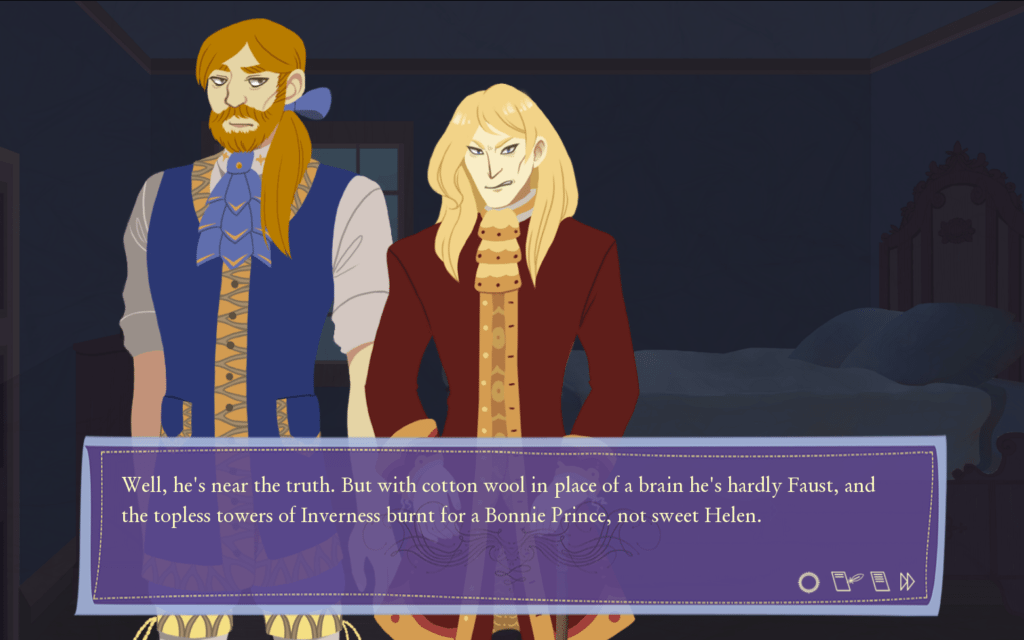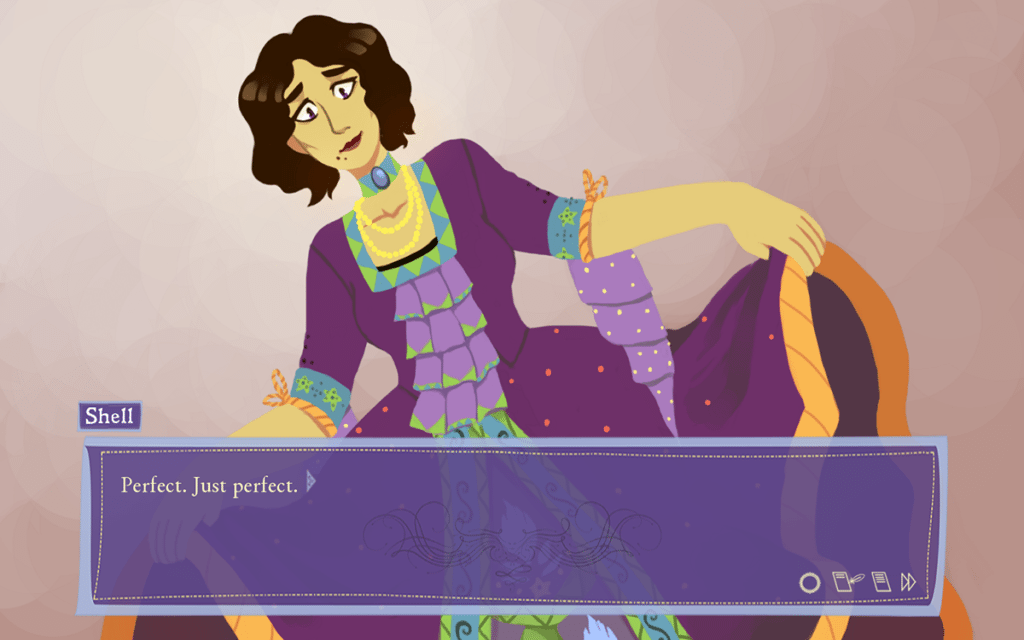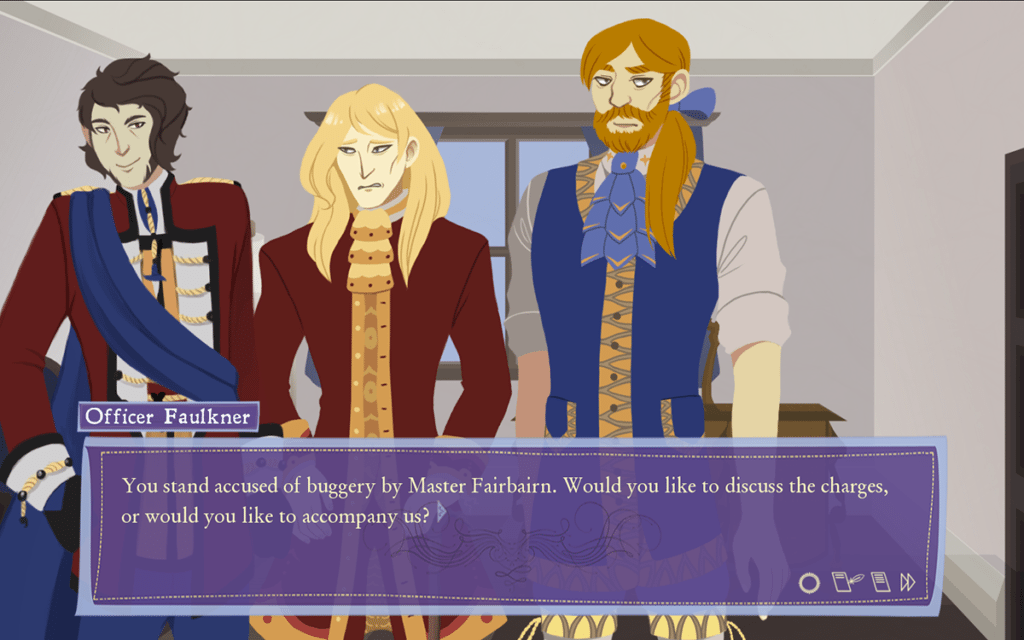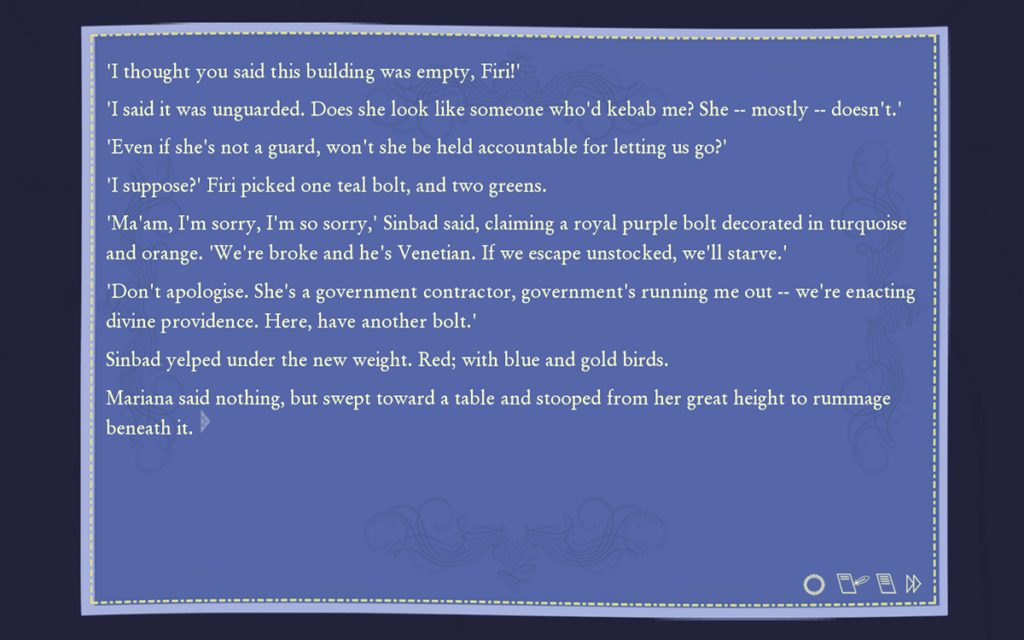Inverness Nights is a visual novel that follows the story of Tristam, a sellsword turned skilled tailor with an unusual talent for curing decay. The game begins in the aftermath of Tristam’s decision to use his unique powers to de-age his partner, Alasdair. With his social standing destroyed and his body plagued by the remnants of his elderly condition, Alasdair swears vengeance on Tristam by threatening to report him for “buggery” (anal intercourse, which is illegal in 18th-century Scotland). Tristam’s only option is to make enough money to leave Inverness, and so the player embarks on a journey to navigate Tristam’s personal and professional life while avoiding the executioner’s block.
Inverness Nights
kitsubasa
June 30, 2017
PC, Mac
Unfortunately, Inverness Nights didn’t make a very great first impression. Without the context of the game’s description (which I skipped over in favor of diving right in), the opening scene of Inverness Nights was confusing. Over the top prose made the story disjointed and hard to follow, and there were several places where it felt like key words had been left out. This murky start to the game lead more confusion after the title card appeared, when Tristram awoke in an armchair and decided he must leave Inverness to avoid arrest (despite never having clearly stated what crime he’d committed). I felt like a child thrown into the deep end of the pool—a very irritating sensation, since I shouldn’t have to read a synopsis to understand what’s happening in a visual novel’s story.

Reading the prose of Inverness Nights is like listening to someone speak in a heavy accent; it’s very challenging at first, and even though you get used to it over time, the confusion never fully goes away. Heavy prose in a visual novel isn’t typically off-putting, but without a strong sense of flow it really bogged me down. I found myself struggling through my first playthrough, waiting for some form of payoff for my toil.
Unfortunately, peeling back the first few layers of obscure dialog isn’t well rewarded. My first playthrough featured only four choices total. At first I thought it was simply easy to stumble into a short, boring story line, but then I finished my second playthrough with only a scant two choices. A perusal of the game’s walkthrough document showed me that the structure of the game’s ending format ensures that at least the first two playthroughs (each of which is about an hour to an hour and a half long without the skip function) feel like a banal waste of time. There are hints in the story that these first playthroughs could lead to a more interesting story line (one tied to Tristam’s immortal nature), but that story is intentionally buried under superfluous requirements that force you to slog your way through to get to the good stuff.
Finding the will to put in the effort was challenging. Part of what made those first few playthroughs almost unbearable was the game’s love interest, Alasdair. Alasdair is rude, bitter, and ineloquent (a.k.a. even more confusing to understand). He’s a crotchety old man in a younger man’s body. He’s prickly and unlikable, which makes pursuing him more of a chore than a pleasure. And, of course, there’s the fact that Alasdair is threatening to have Tristam arrested—definitely not a great foundation for a healthy relationship.
But as I delved further into the story, I realized that the protagonist himself is kind of a dick, too. When Shell, a mysterious yet generous potential patron, first arrives at Tristam’s shop, he immediately scopes out her somewhat unconventional outfit and internally declares her a “fraud” and a “freak.” He thinks she’s “likely feigning luxury for the purpose of whoring.” He judges Shell and then has the audacity to ask her for advice and to a delve into her personal life while declaring that the details of his situation are none of her concern. Tristam is consistently dismissive, haughty, and unwelcoming.

And then there’s his opinion on women, who, according to Tristam, have “too many complexities, too many curves”—a statement that read less like his criticism of creating gowns for the female form and more like a generalization of women as a whole. It rubbed me the wrong way, to the point where my feelings about Tristam tipped towards disdain.
Snap that together with his tumultuous relationship with Alasdair, during which both men commit grievous acts of violence and betrayal against one another (Alasdair destroys Tristam’s half finished commission he’s creating for Shell and Tristam literally throws the crippled Alasdair against the wall and chokes him out, for example), and suddenly two-thirds of the Tristam-Alasdair-Shell pie has gone sour.

Luckily, Shell’s part of the narrative rescues an otherwise irredeemable story. Shell is a rich, enigmatic client that comes into Tristam’s shop right as he’s on the brink of fleeing Inverness. She comes bearing a beautiful purple fabric and she offers Tristam a tidy sum if he can transform the bolt of cloth into a eye-catching gown. Enticed by the possible payoff—and the jump start it could bring to his new life in another city—Tristam accepts her challenge and begins the arduous task of crafting a masterpiece for Shell. While Tristam works, Shell weaves a story about two thieves that conspire to rob the seamstress. The robbery goes awry and soon the three of them are pursuing daring adventures together.
When I first encountered these sudden spans of text, I expected them to be boring. In actuality, Shell’s story was the best part of the game. It only took one session for me to realize that the relationship between Sinbad, Firi, and Mariana is intentionally set up as a comparison for the relationship between Tristam, Alasdair, and Shell. I found myself playing Inverness Nights with a hope of juggling Tristam’s time between Alasdair and Shell in such a way that they might become an unstoppable trio. Unfortunately, my struggles proved fruitless and I quickly became frustrated. After several hours of gameplay with very little satisfaction, I finished one last playthrough (my fifth, I think), and then shut the game off for good, only to come back several hours later and find a mysterious new option waiting for me.
The introduction of this option marks the point where Inverness Nights goes from annoyingly mediocre to intriguing. But after several hours of reading through other endings just to make it to this option, I was too irritated to truly enjoy the good part of the game. Guess it just goes to show that first impressions really are that important.




